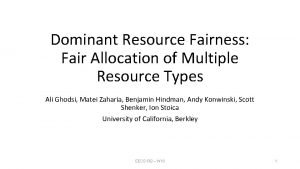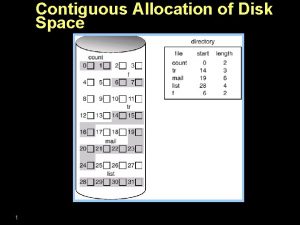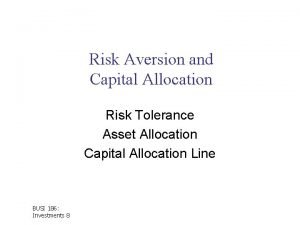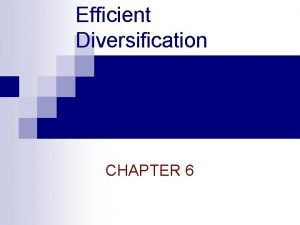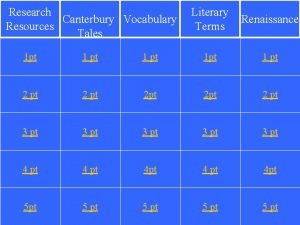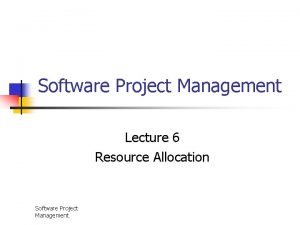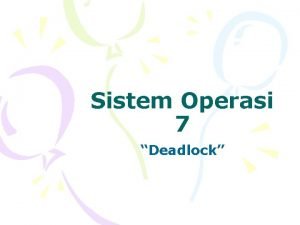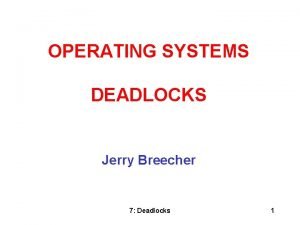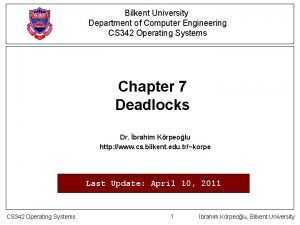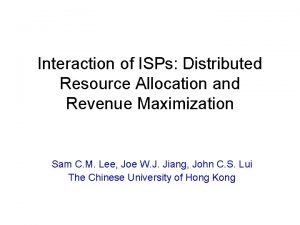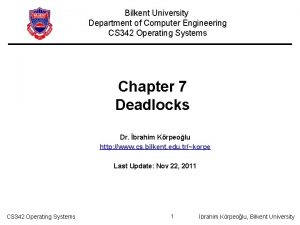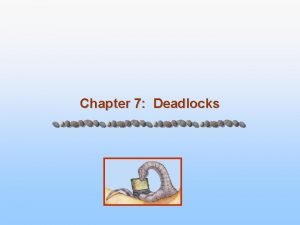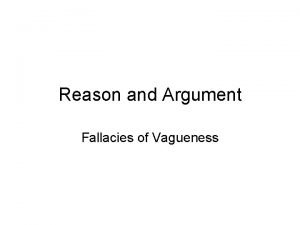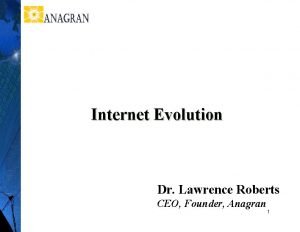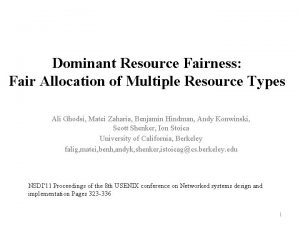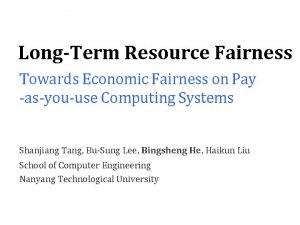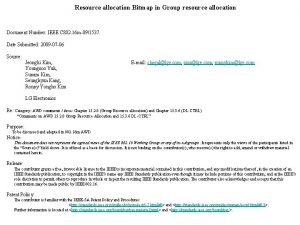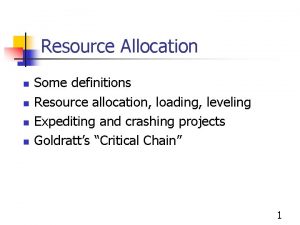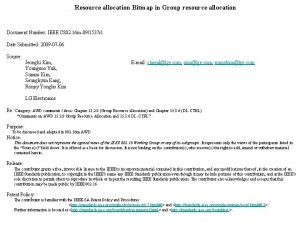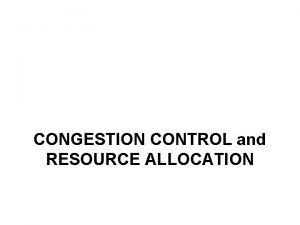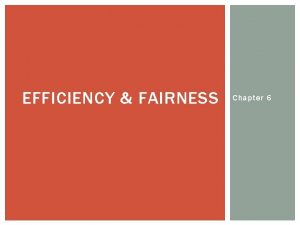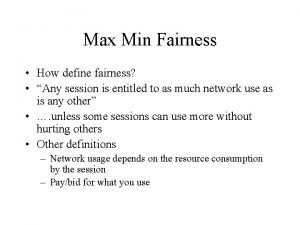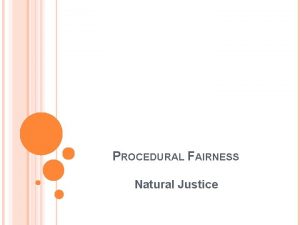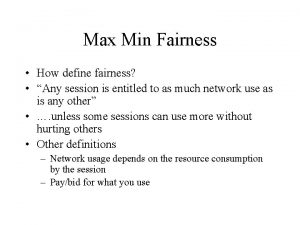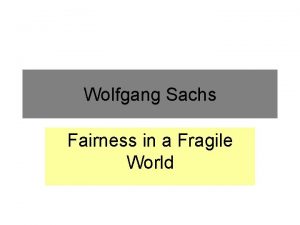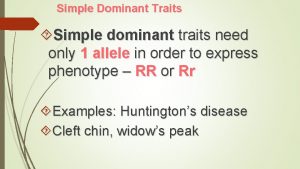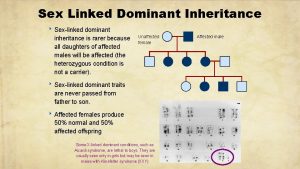Dominant Resource Fairness Fair Allocation of Multiple Resource



























- Slides: 27

Dominant Resource Fairness: Fair Allocation of Multiple Resource Types Ali Ghodsi, Matei Zaharia, Benjamin Hindman, Andy Konwinski, Scott Shenker, Ion Stoica University of California, Berkley EECS 582 – W 16 1

Outlines • Introduction • Motivation • Dominant Resource Fairness (DRF) • Experiment result • Conclusion EECS 582 – W 16 2

What is fair sharing? • n users want to share a resource (e. g. CPU) ‐ Solution: Allocate each 1/n of the shared resource • Generalized by max‐min fairness ‐ Handles if a user wants less than its fair share ‐ E. g. user 1 wants no more than 20% • Generalized by weighted max‐min fairness ‐ Give weights to users according to importance ‐ User 1 gets weight 1, user 2 weight 2 EECS 582 – W 16 3

Properties of max‐min fairness • Share incentive – Each user can get at least 1/n of the resource – But will get less if her demand is less • Strategy‐proof – Users are not better off by asking for more than they need – Users have no reason to lie EECS 582 – W 16 4

Why use max‐min fairness? • Desirable properties of max‐min fairness – Isolation policy: A user gets her fair share irrespective of the demands of other users – Flexibility separates mechanism from policy: Proportional sharing, priority, reservation, . . . • Many schedulers use max‐min fairness – Datacenters: Hadoop’s fair sched, capacity, Quincy – OS: rr, prop sharing, lottery, linux cfs, . . . – Networking: wfq, wf 2 q, sfq, drr, csfq, . . . EECS 582 – W 16 5

Outlines • Introduction • Motivation • Dominant Resource Fairness (DRF) • Experiment result • Conclusion EECS 582 – W 16 6

Why is max‐min fairness not enough? • Job scheduling in datacenters is not only about CPUs – Jobs consume CPU, memory, disk, and I/O EECS 582 – W 16 7

Heterogeneous Resource Demands Some tasks are CPU‐intensive Some tasks are Most task need ~ <2 CPU, 2 GB RAM> memory‐intensive 2000‐node Hadoop Cluster at Facebook (Oct 2010) EECS 582 – W 16 8

Heterogeneous Resource Demands EECS 582 – W 16 9

Motivation • Figure 1 shows that though the majority of tasks are CPU‐heavy, there exist tasks that are memory heavy as well, especially for reduce operations. • Figure 2 shows that most of the tasks either underutilize or overutilize some of their slot resources. EECS 582 – W 16 10

Important Allocation Properties • 1. Sharing incentive: Each user should be better off sharing the cluster, than exclusively using her own partition of the cluster. Every user should get 1/n of at least one resource. • 2. Strategy‐proofness: Users should not be able to benefit by lying about their resource demands. This provides incentive compatibility, as a user cannot improve her allocation by lying. EECS 582 – W 16 11

Important Allocation Properties • 3. Envy‐freeness: A user should not prefer the allocation of another user. • 4. Pareto efficiency: It should not be possible to increase the allocation of a user without decreasing the allocation of at least another user. EECS 582 – W 16 12

Problem Definition • How to fairly share multiple resources when users have heterogeneous demand on them? EECS 582 – W 16 15

An Example of Multiple Resource Sharing ---Example Total Resource: <9 CPU, 18 GB> User A wants <1 CPU, 4 GB> per tasks User B wants <3 CPU, 1 GB> per tasks EECS 582 – W 16 16

A Natural Approach – Asset Fairness • Asset Fairness Aims to equalize the aggregate resources allocated to each user • Total resources <9 CPU, 18 GB> CPU ~ 2$ 1 GB ~ 1$ User 1 wants <1 CPU, 4 GB> ~ 6$/tasks User 2 wants <3 CPU, 1 GB> ~ 7$/tasks • Solution Find max(x, y) such that 6 x = 7 y x=2. 52, y=2. 16 1 gets <2. 5 CPU, 10. 1 GB> 2 gets <6. 5 CPU, 2. 2 GB> EECS 582 – W 16 17

A Natural Approach – Asset Fairness • Drawback of Asset Fairness Violates the sharing incentive property • Counter Example • Total resources <30 CPU, 30 GB> User 1 wants <1, 3> User 2 wants <1, 1> Solution: User 1 gets <6, 18> ~24/60 User 2 gets <12, 12> ~24/60 User A gets less than half of both resources! EECS 582 – W 16 18

Dominant Resource Fairness - DRF • Allocation policy for multiple resource • Meets all four of the required policy: • • Sharing incentive Strategy-proofness Envy-freeness Pareto efficiency EECS 582 – W 16 19

Dominant Resource Fairness - DRF • Dominant Resource: The resource that a user has the biggest share of Example: Total resources: <9 CPU, 18 GB> User 1’s allocation: <3 CPU, 4 GB> Dominant resource is memory for 3/9>4/18 • Dominant Share: • The fraction of the dominant share a user is allocated User 1’s dominant share is 33% (1/3) EECS 582 – W 16 20

Dominant Resource Fairness - DRF • Apply max-min fairness to dominant shares • Equalize the dominant share of the users • Solution to the example • Total <9 CPU, 18 GB> • User 1 <1 CPU, 4 GB> User 2<3 CPU, 1 GB> • max(x, y) (Maximize allocations) such that 2/9 x = 3/9 y (equalize dominant shares) • Solution: User 1<3 CPU, 12 GB>, User 2<6 CPU, 3 GB> EECS 582 – W 16 21

Alternative Fair Allocation Policy: CEEI • Economist’s way to fairly divide resources • Competitive Equilibrium from Equal Incomes: • Give each user 1/n of every resource initially • let them trades their resources with other users in a perfectly competitive market • Solution given by Nash barging solution EECS 582 – W 16 24

Alternative Fair Allocation Policy: CEEI • Market Clearance • Drawback : Violate strategy proofness • User can cheat by claiming more than he needs to have more tasks allocated EECS 582 – W 16 25

Comparison Between Three Allocation EECS 582 – W 16 26

Comparison Between Three Allocation • DRF is the only one satisfying four required properties • Resource monotonicity is not possible to achieve when other properties are achieved EECS 582 – W 16 27

Experiment Result • Experiment: DRF vs. Alternative Allocation Policies • 48 node Mesos cluster on EC 2 instances with 8 CPU cores and 7 GB RAM each (1 GB for OS). • Two users: • User 1 <1 CPU, 0. 5 GB> • User 2 <2 CPU, 2 GB> • Compared with: • Slot-based fair scheduling (a common policy in current system, e. g. Hadoop Fair Scheduler) • Max-min fair sharing for CPU resource only EECS 582 – W 16 28

Experiment Result EECS 582 – W 16 29

Conclusion • DRF provides multiple‐resource fairness in the presence of heterogeneous demand • First generalization of max‐min fairness to multiple‐resources • DRF satisfies all of the desired properties of fair allocation except for resource monotonicity • DRF performs better than current approaches. EECS 582 – W 16 32

Acknowledgement • Some of our slides are borrowed from their presentation in NSDI in 2011 EECS 582 – W 16 33
 Dominant resource fairness
Dominant resource fairness Resource leveling is the approach to even out the peaks of
Resource leveling is the approach to even out the peaks of Contiguous allocation vs linked allocation
Contiguous allocation vs linked allocation Dominant capital allocation line
Dominant capital allocation line Portfolio diversification
Portfolio diversification Fair is foul and foul is fair macbeth
Fair is foul and foul is fair macbeth Is a sonnet 14 lines
Is a sonnet 14 lines Syntax literary devices
Syntax literary devices Foul is fair and fair is foul literary device
Foul is fair and fair is foul literary device Significa fair play
Significa fair play Macbeth literary devices
Macbeth literary devices Examples of fair is foul and foul is fair in macbeth
Examples of fair is foul and foul is fair in macbeth Strategy formation
Strategy formation Software project management resource allocation
Software project management resource allocation Deadlock sistem operasi
Deadlock sistem operasi Resource allocation graph in os
Resource allocation graph in os Algoritmo banchiere
Algoritmo banchiere Deadlock
Deadlock Resource allocation graph in os
Resource allocation graph in os Resource allocation graph and wait for graph
Resource allocation graph and wait for graph Resource aggregation
Resource aggregation Distributed resource allocation
Distributed resource allocation Cs 342 bilkent
Cs 342 bilkent Resource allocation graph
Resource allocation graph Keva cream
Keva cream Line-drawing fallacy
Line-drawing fallacy Fairness scenarios
Fairness scenarios Fairness and flawless ceo
Fairness and flawless ceo
